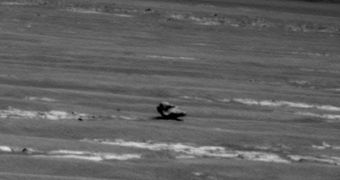NASA's resilient rover Opportunity has recently discovered a rock that could very well be another meteorite on the surface of Mars. Mission controllers are now deciding whether to investigate it.
If the discovery is confirmed, then this would be the rover's fifth meteorite. The explorations robot, which has been roaming the Red Planet for more than six and a half years, is very well equipped to study such features.
At their origins, both Mars Exploration Rovers (MER) are geology observers. Their robotic arms feature abrasion tools that allow them to peer deep into rock by cutting tiny holes in them.
Over the years, as Opportunity was roaming the land, it came across several such space rocks, which most likely fell on Mars billions of years ago.
Experts hope that in-depth analysis of these meteorites would provide more clues to both the early solar system and to how the Martian atmosphere looked like all those years ago.
By determining the age of a space rock, and also the way it burnt before hitting the surface of the planet, experts can calculate the chemical composition of the atmosphere.
If they are able to find rocks from different periods, then they are able to piece together a time-lapse map of how the Martian air changed over time, and extrapolate its future based on those models.
According to officials at the NASA Jet Propulsion Laboratory (JPL), in Pasadena, California, the new rock was seen in Opportunity images dated September 16.
The robot took the images just after it finished a 81-meter (266-foot) drive. The possible meteorite is no larger than a toaster, and is estimated to be about 31 meters (102 feet) away from Opportunity.
“The dark color, rounded texture and the way it is perched on the surface all make it look like an iron meteorite,” explains JPL scientist Matt Golombek, a part of the rover science team.
The rock has now been called Oilean Ruaidh, an experts say that it looks like it's around 45 centimeters, or 18 inches, in diameter.
Mission managers are currently trying to determine whether to stop and investigate this meteorite, or push on with their effort to reach Endeavour Crater.
Thus far, Opportunity has driven more than 14.5 miles (23.3 kilometers) on the surface of Mars, but it still has a long way to go before it reaches the impact feature.
JPL controllers decided to go there because the large structure may have exposed layers of the Martian crust that are inaccessible to the rover in other circumstances.
Analyzing them may reveal more clues as to what happened in the Red Planet's climate past, Space reports.

 14 DAY TRIAL //
14 DAY TRIAL //